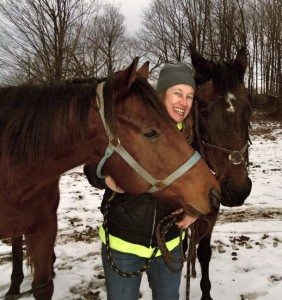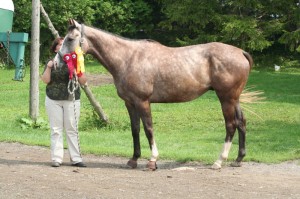They’re the size of pencil lead, but as an identification tool for racehorses, the implantable microchip leaves an indelible mark; one that neither fades nor blurs with the passage of time.
For it’s undeniable accuracy in revealing the identity of a Thoroughbred racehorse, and other breeds, use of the microchip has been embraced in the European horse world, according to Bob Curran, the Jockey Club’s vice president of corporate communications.
“They’re a really good means of secondary identification,” says Curran, noting that in 2008, the Jockey Club began encouraging Thoroughbred owners to microchip their horses, offering them for sale on their website for a mere $10 each.
Manufactured by Destron Fearing, the international “standard” among microchips, approximately 1,600 have been sold since they first appeared on their site, according to Andrew Chesser, customer service coordinator in microchipping for the Jockey Club.
“We have a steady handful of customers who order chips on a yearly basis, mainly for horses who are being exported out of the country,” Chesser says. “Our main microchip customers are purchasing them for that explicit purpose, because in Europe, the Thoroughbred Stud Book requires it.”
Thoroughbred-welfare advocates are also on the bandwagon, and have recently begun advocating their use, contending that microchips could help better identify racehorses in need, or who have perhaps become imperiled.
In a recent Q&A with OffTrackThoroughbreds, former racehorse owner and breeder Jill Pflugheber, further suggested that a horse’s identification number, embedded in a microchip, might assist horse-rescue workers in tracking down the animal’s important history.
“While lip tattoos are the standard, maybe microchipping should be required, as well. Lip tattoos can be difficult to read—although flipping a lip to see a tattoo is a quick way to identify a horse that’s been at the track, the microchip could easily be tied to an electronic database in which contact information of all owners, trainer, and breeder information could reside.”
Further discussion of microchipping has made its way to social media message boards, and even Ray Paulick, publisher of The Paulick Report, Tweeted a message recently about microchipping after 10 Thoroughbred broodmares were rescued from a Texas auction frequented by kill buyers who sell horses to slaughterhouses.
Although the idea of microchipping may seem simple, there are several factors to consider, says Rood & Riddle veterinarian Dr. Woodrow Friend.
Dr. Friend has done several microchipping procedures, and says, in principal, it’s a great idea. However, similar to computer technology that must run on compatible software, microchips can only be “read” by compatible scanners, he points out.
This poses a problem. Namely, which chips and scanners should a veterinary service or auction purchase, and who bears the responsibility for cost?
Friend also said that a recent effort to make Coggins reports available on a global veterinarian link became cost prohibitive. Software fees, which would ultimately be passed on to the veterinarian client, made the idea something of a “logistical nightmare,” and it was ultimately abandoned.
Although on principal, Friend is in favor of better identification methods, he says logistics need to be worked out to streamline the process.
He predicts that with the rising interest in identification methods, the world may one day even see the advent of retinal scans for racehorse identification.
“Retinal scans have been tested on horses. They have it now, but the question becomes: Is it feasible? And, into whose hands do we entrust the scanners? Who controls it and how much does it cost?”
As these and other ideas bubble to the surface, the Jockey Club, an avowed opponent of the slaughter of Thoroughbred racehorses for human consumption, continues to help the public with ex-racehorse identification.
“If someone has a horse with only a partially readable tattoo, they can send us that information as well as the horse’s markings and photographs, and we will identify that horse, free of charge,” Curran says.
The Jockey Club also offers a service called Thoroughbred Connect, which is a data collection point for people interested in a particular racehorse’s welfare. Should the need arise, fans, past owners of the horse—anyone who feels they will be in a position to help—can input their own contact information.
“For any horse that’s in our database, a person who wants to be available to help the horse later on, in case he ever needs assistance, can stay connected through Thoroughbred Connect,” Curran says.
Both Curran and Chesser applaud the use of microchips as a great secondary way to identify a horse.
“They’re safe and effective, and when used in combination with our current methods of identification —tattooing, markings, and photographs, it’s a terrific secondary identification,” Curran says.
Whether the use of microchips in this country catches on as it has in Europe, Pflugheber, feels buoyed by the positive strides being taken to support Thoroughbreds.
“The Thoroughbred racehorse industry has certainly made great strides forward in the desire to take care of these wonderful animals,” Pflugheber states in the earlier Q&A. “Some racetracks have funds set aside to assist retiring Thoroughbreds. And some even go a step further, putting a program into place that sanctions the connections of horses found going to slaughter. These programs are all individually administered by the racetrack.
“Another positive, is a program offered by The Jockey Club, which allows owners to contribute money at the time of foal registration, towards the welfare of that horse.”
For more information about microchipping, please see this Jockey Club Page. To watch a horse receive a microchip, please see the follow video, courtesy of Penn State.







Breaking news: EU regulations announced, the beginning of the end of the US slaughter trade:
http://horsebackmagazine.com/hb/archives/17163
The EU wants every US horse microchipped, every dose of Bute, etc recorded in a lifetime passport, in order for the US to keep exporting horses for slaughter to EU.
There is no domestic market for horse meat, EU is the major market.
US does not have an EU approved inspection plan in place, so the US exports of horses for slaughter to EU ends this year.
Ending this trade will be good news for the markets! US is known as the country that breeds for low quality and high quantity, with the slaughter trade enabling the bottom end.
There is no way the US taxpayers will want to pay for EU mandated monitoring on US soil, with cuts to our own food safety programs.
There’s no way US horsemen will go along with the burden of record keeping (so a very few can keep slaughtering instead of calling a vet) or paying their vet to sign off on medications they can now give themselves. Gone will be the days of a tube of Bute in the barn for an emergency.
Now we can explore the value of micro-chipping for our own needs, to manage our horse market and allow people to follow up with TBs they bred, owned etc over the years. Horse thieving will go down, too.
This is great news for horses, and horsemen!
Wow! This is fantastic news Saratoga! Thanks for sharing it.
I agree with all of the positives of this program,especially, anything that will help control drugging and slaughtering all horses of any sport!
Of significance is that in 2013 laws go into effect according to the new EU standards for horse meat. The requirement is for FAIS microchipping with medical history similar to the european horse passport system. Medical records must include a record of all drugs administered in a horse’s history on the chip. Horses receiving bute or another prohibited med will be required to spend 180 days in a holding facility (feedlot).
Since USDA inspectors will be performing the scanning, costs for the inspectors themselves and the additional costs related to time scanning and purchase of scanners will be borne by U.S taxpayers.
The most unique aspect of this requirement is that it will allow identification of every single horse identified for slaughter. Currently, identification ny breeds is determined by how a KB writes up his bill of lading. Ie, on a 40 horse load he may list 4 Qtr, 4 TB and 32 grade horses, but with every horse identified the Jockey Club and other breed registries will have accurate numbers of TBs sent to slaughter including those who have never been tattooed or defaced tattoos. The laws on FOIA make this information public to anyone requesting it.
To clarify, the food safety laws for Bute ban it altogether in food animals.
Because of serious medical impacts on humans, Bute is a drug with no legal withdrawal period for food animals. One dose and out. One hears excuses about that, but the science is compelling. The ban on Bute in food animals is a settled matter.
Our organization’s blog in June 2012 below addresses the need for better tracking and monitoring of off the track thoroughbreds. Will it take time and money, yes but it is an investment that the industry must take seriously and is needed and well worth it to help to protect the lives of thousands of thoroughbreds each year that retire from racing.
http://racefundnews.blogspot.com/2012/06/national-database-to-monitor-retired.html?spref=bl